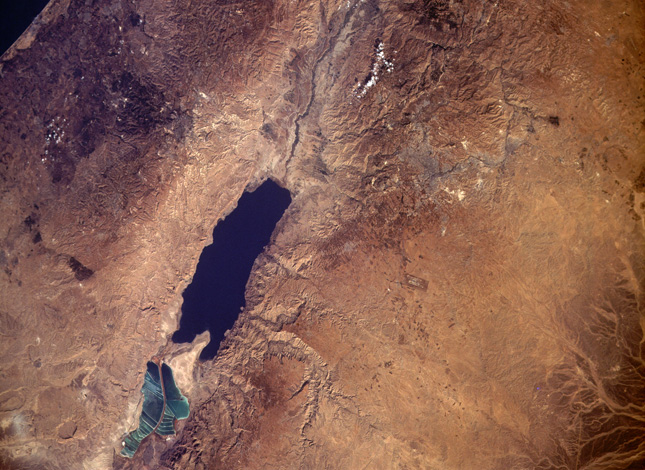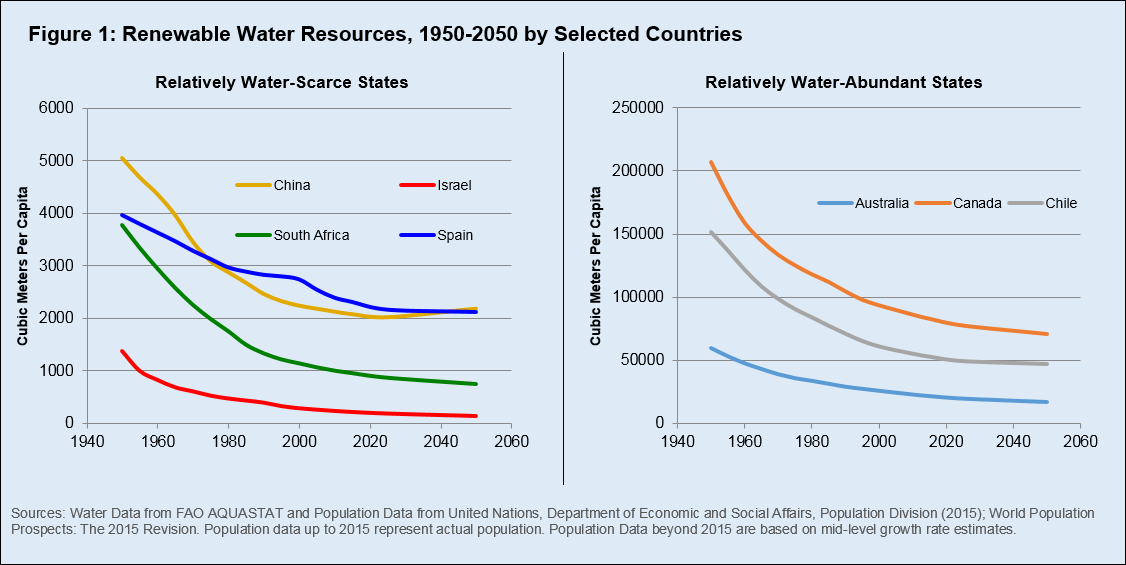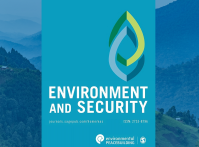-
Lessons From International Water Sharing Agreements for Dealing With Climate Change

Scientists agree that many countries in tropical, subtropical, and arid regions should expect changes to water availability and supply from climate change. The U.S. intelligence community has likewise warned of water-driven challenges not only for countries directly affected by water changes, but indirectly to various U.S. national security interests. Perhaps not surprisingly then, the popular literature has been quite clear about prophesizing wars over water.
The academic literature, however, has been more cautious. Political disputes over water are certainly not uncommon and much of the literature has attempted to explain how such conflicts have transpired, but the prospect of all-out war over water dates back to only one incident 4,500 years ago.
In fact, another set of literature has focused on the links between water and cooperation. The central argument is that since water is necessary for survival, it elicits negotiation when parties need to work together to share or develop and manage transboundary freshwater resources.
The theory developed in our new book, International Water Scarcity and Variability: Managing Resource Use Across Political Boundaries, departs from the argument that a simple relationship exists between water scarcity and cooperation, suggesting instead that there is a non-linear relationship, or hill-shaped curve, where low scarcity and low variability on one end and high scarcity and high variability on the other both produce little cooperation, while the middle zone tends to produce more. We also note that the particulars of water sharing and governance policies matter a great deal.
Acknowledging that various security concerns do arise from environmental change and increasing water scarcity and variability – though nearly always short of war – the book focuses on the cooperation-inducing characteristics of international freshwater resources, the treaties that countries have negotiated to resolve their disputes, and the mechanisms codified in treaties that make agreements more or less effective.
Treaty Mechanisms and Cooperation
There have been calls for more transboundary water treaties to help deal with climate change and water scarcity, and the academic literature demonstrates that there is indeed a positive relationship between the presence of a treaty and subsequent cooperation in a given basin. Yet beyond the mere presence of a treaty or treaties, what else is it about an international agreement that motivates cooperation?
Building on the extant literature and analyzing a large number of treaties as well as water events and other political data, the book demonstrates the importance of institutional mechanisms. River basins governed by agreements that include a combination of institutional mechanisms (such as enforcement, monitoring, conflict resolution, side-payment/issue-linkage, adaptability, and a joint basin commission) tend to exhibit more cooperation than river basins governed by agreements that don’t embody this combination of mechanisms. River basins governed by agreements that include an enforcement and adaptability mechanism as well as a side-payment or issue linkage features – something that constitutes a financial incentive or combines discussions about water with other aspects of bilateral or multilateral relations – are particularly prone to increased cooperation.
Even under “ideal” conditions, almost every region of the world faces serious water scarcity that is increasing with timeThe type of water allocation mechanisms codified in an agreement also matters for treaty effectiveness under conditions of water scarcity and variability. In regions already governed by a water treaty, climate change and subsequent water variability could affect the ability of basin states to meet their water agreement commitments and effectively manage transboundary waters, especially if agreements are not designed to deal with environmental change and similar forms of uncertainty (as is the case for many).
Certain allocation mechanisms are more effective in dealing with climate change and subsequent water variability. In particular, basins governed by agreements that include an allocation mechanism that evinces both flexibility and specificity lead to more cooperation among the basin riparians than agreements that are either too rigid in determining the allocation or too vague.
A good example of a flexible yet specific allocation mechanism is one that divides available water by percentages as opposed to absolute values. The latter allocation mechanism certainly prescribes a specific type of allocation, but could create conflict if the total amount of water available each year changes, which under conditions of climate change is of high likelihood.
The same can be said about allocation mechanisms that are flexible yet too open-ended. Vague allocation mechanisms sometimes include general principles such as “consultations between the parties” and “prioritization of uses” as well as “equitable utilization” and “needs-based” approaches. These principles are imprecise and subject to negotiation.
The book features two chapters that apply the theoretical arguments and results from the large, cross-national data analyses to case studies around the world; among them, are the Nile and Jordan Basins.
The Blue Nile
The Blue Nile Basin is an interesting case because Addis Ababa has already moved forward on building the large and disputed Grand Ethiopian Renaissance Dam. With the construction of this mega project, which will store 79 billion cubic meters of water and produce 6,450 megawatts of hydroelectricity, Ethiopia is challenging the prevailing hydro-political regime that has, for decades, benefitted downstream Egypt and to some degree Sudan.
But the Grand Renaissance Dam could provide benefits to Egypt and Sudan. In addition to the large amounts of hydropower that could be sold to downstream states, better water storage facilities could reduce evaporation rates and thus make more water available to all three riparians. Furthermore, regulation of the river in Ethiopia could effectively eliminate the annual Nile flood, making the flow of water reaching Sudan and Egypt seasonably stable and providing Sudan with perennial storage capacity. These benefits in turn could be compensated through side-payments or other forms of issue-linkage negotiated through diplomacy.
It is perhaps little surprise that the construction of the dam prompted a 2015 re-negotiation of some issues among Egypt, Sudan, and Ethiopia. While the agreement deals with general principles of cooperation and trust building, as opposed to basin-wide distribution of the Nile’s waters, it represents a major shift in Egypt’s overall approach to the river and may perhaps usher in a basin-wide agreement that can benefit all riparians.
The Jordan
In the Jordan River Basin, the relationship between Israel and Jordan dominates the hydro-regime. The 1994 peace agreement between the two introduced provisions for the alleviation of water shortages. While the agreement allocates fixed volumes of water, as opposed to a more flexible strategy, it does include other alternative and innovative ways of sharing resources. These include clauses indicating strategic cooperation over desalination and wastewater reclamation; exchange of diversions to Jordan from Lake Kineret in the north of Israel for the same amount of groundwater pumped by Israel in the Arava Valley; joint projects to find new water sources during drought years; and permanent supplies to meet the needs of both sides during dry periods.
The future of the Dead Sea has become a much more prominent concernWhile very comprehensive, the treaty at the time of its negotiation did include several ambiguities that, by some accounts, have become “destructive” to its performance. There were open questions as to who pays for water conveyance, the location of storage, and the source of an additional 50 million cubic meters per year to be discharged to Jordan. In addition, over time Israel has not always been able to honor its water discharge commitments during dry spells, in part because the amount to be transferred is fixed. A deficit in delivery during the 1998-2000 drought, for example, was solved by a summit of the heads of state, who agreed to divide the burden. Israel would deliver to Jordan only 25 million cubic meters per year until a desalinization plant was operational so as to provide the full quota. Today, according to Itay Fischhendler of the Hebrew University of Jerusalem, largely to help Jordan deal with the influx of refugees from Syria, Israel delivers to Jordan the entire 50 million cubic meters.
In recent years, the future of the Dead Sea has become more prominent in the relationship between Jordan and Israel. Intense and prolonged droughts; increases in population in Israel, Jordan, and the Palestinian Authority; and more water diversion upstream, including to storage in Syria, have all contributed to catastrophic environmental damage in the lower Jordan Basin. The Dead Sea has lost one third of its surface area and is expected to dry up if this trend continues.
In response, Israel, Jordan, and the Palestinian Authority, with World Bank support, have been investigating the so-called “Red-Dead Project,” which calls for massive investments in desalinization of Red Sea water to be conveyed north to urban centers in all three territories. Israel would release more water from its Lake Kineret in exchange for the desalinated water, and the brine produced during the desalination process would be pumped into the Dead Sea in an attempt to sustain it.
In March 2015, Israel and Jordan signed an agreement for a scaled-back project, a $900 million desalination plant to be built in Jordan to supply water to southern Jordan and sell to Israel. In return, Israel will sell more water to Jordan from the Sea of Galilee. The brine byproduct, estimated at 1,200 million cubic meters per year from desalination, will be mixed with seawater and conveyed 180 kilometers from the Red Sea to the Dead Sea.
Less Than Ideal
A close reading of allocation mechanisms and posturing in the Nile and Jordan River Basins is vital for analysts seeking to prepare for a climate changed future. Because of increasing population and consumption, even under “ideal” conditions of water resource management – with no external factors such as climate change – almost every region of the world faces serious water scarcity that is increasing with time.
There are several metrics for water scarcity. We use the total renewable available water resources per capita as a measure for scarcity, which is based on the fact that the amount of water in circulation is more or less fixed and the world population increases over time. These two facts are by themselves sufficient to describe the global dynamics of water scarcity. As seen in Figure 1, over the last century, some countries have lost 50-75 percent of their renewable water per capita.
What’s more, we found that water availability is reciprocally correlated with variability – countries with higher level of scarcity also face higher levels of variability. A more variable water supply poses difficulties in planning, storing, and using water, all of which make water effectively scarcer. Additional losses due to mismanagement, externality impacts (e.g., pollution), and climate change could lead to catastrophes.
Understanding when cooperation is more or less likely to transpire based on levels of water scarcity and variability provides policymakers with important context for negotiation. In addition, learning what has worked and what has not in international water agreements and the correct balance between flexibility and specificity is key to preventing poor outcomes, whether violent or not. Policymakers should look to include a combination of enforcement, monitoring, conflict resolution, adaptability, and other institutional mechanisms to craft the most effective treaties. The full toolbox of water diplomacy is clearly needed for the challenge ahead.
Shlomi Dinar is associate dean for graduate studies and innovation at the Steven J. Green School of International and Public Affairs and associate professor in the Department of Politics and International Relations at Florida International University.
Ariel Dinar is professor of environmental economics and policy at the School of Public Policy, University of California, Riverside.
Sources: Food and Agriculture Organization of the United Nations, Foreign Policy, Intergovernmental Panel on Climate Change, International Interactions, Itay Fischhendler, Journal of Peace Research, Shlomi Dinar and Ariel Dinar (2016), The Sustainability Consortium, UN Population Division.
Photo Credit: The Dead Sea, September 1992, courtesy of NASA. Figure 1: Used with permission courtesy of Shlomi Dinar and Ariel Dinar.
Topics: adaptation, Africa, climate change, conflict, cooperation, Egypt, environment, environmental health, environmental peacemaking, environmental security, Ethiopia, featured, foreign policy, Guest Contributor, hydropower, international environmental governance, Israel, Jordan, Middle East, natural resources, Palestinian Territories, population, security, South Sudan, Sudan, Syria, water
 A Publication of the Stimson Center.
A Publication of the Stimson Center.








